How National Grid Strain Affects Your Home — Lessons from Spain and Portugal

In April 2025, millions of homes in Spain and Portugal experienced a sudden and widespread blackout. Without warning, electricity was cut off across both countries. The cause wasn’t a storm or cyberattack. It was a major issue with the energy grid. Spain suddenly lost about 15 gigawatts of power, and to protect its own system, Portugal disconnected from Spain’s grid. The result? A chain reaction that left people without lights, hot water, or heating.
What happened in the Iberian Peninsula shows how even well-developed energy systems can fail, especially when the grid is under pressure. And while this happened abroad, it’s a valuable lesson for households in the UK, where our own energy system is changing fast.
What Is Grid Strain — and Why Should You Care?
The energy grid works by keeping a balance between supply and demand. At every moment, the amount of electricity being used needs to match the amount being produced. When that balance is thrown off, either because there’s too much energy or not enough, the grid can become unstable.
In the past, big power stations helped keep things stable. They added something called inertia, which made the system more resistant to sudden changes. But now, as more electricity comes from solar panels and wind turbines, we lose that built-in stability. These clean energy sources are important, but they’re also less predictable.
When demand spikes or supply drops suddenly, the grid can’t always cope. That’s what we call grid strain and when it gets too high, power cuts can happen.
You should care because grid strain can lead to:
- Sudden blackouts or brownouts in your area
- Higher energy prices during peak usage
- Less control over how and when you use electricity
- Increased pressure on a system that’s already under stress
The Hidden Challenges of Renewable Energy
Clean energy is essential for the planet, but it brings new challenges.
Solar panels only work when the sun is shining. Wind turbines only generate power when it’s windy. That means the energy supply can change quickly and unpredictably.
In the case of Spain and Portugal, there was actually too much electricity in the system at one point. When parts of the grid couldn’t handle it, they shut down to protect themselves. The blackout wasn’t caused by a lack of energy, it was caused by a system that couldn’t adjust fast enough.
The main challenges of integrating renewable energy include:
- Lack of energy storage to hold excess power for later use
- Grid inflexibility, especially in older infrastructure
- No real-time response tools for households
- Limited communication between national and regional systems
This shows how important it is to upgrade our grid systems to match the growth of renewable energy.
How the Iberian Blackout Happened
Spain’s grid suddenly lost 15 gigawatts of power- a massive amount. This caused serious instability, and the system began to shut down sections to avoid a total collapse. Portugal, which shares a power link with Spain, disconnected to avoid being pulled down with it. But in doing so, many Portuguese homes lost power as well.
Key takeaways from the event:
- The grid lacked the flexibility to absorb a sudden loss in power
- Backup systems couldn’t respond quickly enough
- Portugal’s disconnection helped protect its grid but came at a cost
- Consumers had no warning and no way to reduce their demand
It also highlights that consumers had no real-time tools to reduce strain or avoid costly energy use.
Could This Happen in the UK?
Yes- while the UK has a strong grid, we’re also seeing more strain, especially during extreme weather or sudden demand spikes. We’re using more renewables than ever, which is great, but we also need better systems to manage when and how that energy is used.
Here’s what’s happening in the UK:
- Renewable energy is making up a bigger share of supply
- Smart meter rollouts are still incomplete in some areas
- Home energy demand is increasing with the rise of EVs and electric heating
- Peak pricing is becoming more common as a way to control strain
If you’re using electricity during peak times without knowing it, you might be paying more and putting extra pressure on the grid.
How Quarta Helps You Respond in Real Time
That’s where Quarta can help. Most people can’t see what’s happening with the grid, but Quarta gives you a clear view of your energy use and how it connects to the bigger picture.
With Quarta, you can:
- Track your energy usage in real time
- Get alerts when the grid is under pressure
- Avoid expensive peak hours
- Plan energy use around weather conditions and forecasts
- Lower your impact without sacrificing comfort
- Understand your costs clearly and take action when it matters most
This gives you the tools to use energy smarter — for your home, your wallet, and the grid.
What We Can Learn from Spain and Portugal
The Iberian blackout showed us that:
- Infrastructure needs to be modernised to support renewables
- Energy storage (like batteries) must be part of the solution
- Consumers need better tools to understand and respond to what’s happening
- Smart planning and investment are key to preventing future blackouts
- Regional grid connections must be backed by local resilience
Quarta is part of that solution- helping people like you stay informed, save money, and make smarter energy choices.
Final Thoughts
What happened in Spain and Portugal wasn’t just a one-time event- it’s a warning. Even advanced systems can fail if they’re not designed for the fast pace of modern energy use.
But there’s good news: with smart meters, better infrastructure, and tools like Quarta, we can avoid these problems. We can build a system where every home plays a role in keeping the lights on- affordably, sustainably, and reliably.